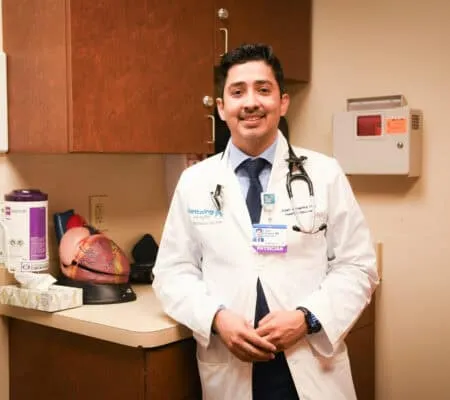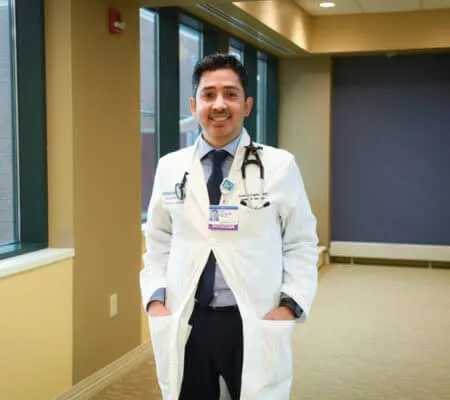At Kettering Health, cutting-edge heart and vascular care is close to home. We’re here to help you navigate the symptoms, diagnosis, and treatment of a heart arrhythmia, often known as an irregular heartbeat.
Your physician may suspect a heart arrhythmia if you feel the following:
- A fluttering sensation in your chest
- Fatigue
- Lightheadedness
- Shortness of breath
- Or even anxiety
If so, we offer several tests to help diagnosis arrhythmia along with many treatment options to help you get back to your best health.
Atrial Fibrillation (AFib)
AFib is the most common type of irregular heartbeat (arrhythmia) that can lead to blood clots, stroke, heart failure, or other health complications. If you have AFib, you’re not alone: nearly 3 million Americans live with AFib.
In AFib, the upper chambers of the heart (the atria) beat irregularly, affecting how blood moves through the ventricles. If a clot forms as a result and breaks off, entering the bloodstream, it can lodge in an artery leading to the brain, leading to a stroke. About 15-20% of those who have a stroke have this heart arrhythmia.
If you think you may have AFib or are feeling other symptoms of a heart arrhythmia, contact us to make an appointment. A member of our team will work to make a diagnosis and create the treatment plan that’s right for you.
Diagnosis
Your heart health matters. We offer several tests to diagnose an arrhythmia and discern the best course of care.
- Electrocardiogram (ECG): An ECG measures the electrical activity of your heart. Electrodes are placed on your body (chest, arms, and legs) to generate your heart’s electrical activity. An ECG can show the presence of arrhythmias, damage to your heart caused by ischemia (lack of oxygen to the heart muscle), myocardial infarction (MI or heart attack), a problem with one or more of the heart valves, or other types of heart conditions. ECGs may be done while lying down (resting or sing-averaged ECG) or exercising (stress ECG).
- Electrophysiologic studies (EPS): A non-surgical but invasive test in which a small, thin tube (catheter) is inserted into a large blood vessel in your leg or arm and advanced to your heart. This lets your doctor find the site of the arrhythmia’s origin within your heart tissue.
- Holter monitor: A small, portable ECG recorder that records 24 hours of electrocardiographic signals.
- Event monitor: This is similar to a Holter monitor, except the ECG recording begins only when you feel symptoms. Event monitors are typically worn longer than Holter monitors. You can remove the monitor to shower or bathe.
- Implantable loop recorder: This is a miniature heart-recording device that is implanted underneath the skin that overlies your heart. It records the heart rhythm for up to 2 years and is useful to diagnose intermediate or rarely occurring arrhythmias.
Arrhythmia Treatment
We have many treatment options available, depending on the type and stage of irregular heartbeat or heart arrhythmias. From medication management to surgical intervention, an experienced cardiac electrophysiologist will find the right treatment option for you.
Factors such as smoking, alcohol, and stress can lead to an arrhythmia. Depending on the severity, your physician can help you control and monitor your heart rhythm with prescription medication.
Types of Treatment
- Ablation: This is an invasive but non-surgical procedure done in the electrophysiology lab. The physician puts a catheter into your heart through a vessel in your groin or arm. The procedure uses high-frequency radio waves to heat the tissue to destroy the site.
- Cryoablation: Similar to ablation, this uses an ultra-cold substance on the site. This freezes the tissue and destroys the site.
- Cardioversion: The physician sends an electrical shock to your heart through the chest. This stops certain fast arrhythmias, such as atrial fibrillation, supraventricular tachycardia, or atrial flutter. The electrical shock is delivered during the ECG cycle to change the rhythm to a normal one.
- Implantable cardioverter defibrillator (ICD): A small device is put under the skin, often under the collarbone. An ICD senses the rate of the heartbeat, sending an electrical shock to the heart when the heart rate goes higher than the level entered into the device. This corrects the rhythm to a slower heart rhythm. ICDs are used with a pacemaker to send an electrical signal to regulate a slow heart rate. We use ICDs for life-threatening fast arrhythmias such as ventricular tachycardia or ventricular fibrillation.
- Lifestyle changes: Stress, caffeine, and alcohol can cause arrhythmias. Your provider may recommend you avoid caffeine, alcohol, or other things that may cause the problem. If your provider thinks stress is a cause, he or she may recommend meditation, stress-management classes, an exercise program, or psychotherapy to ease stress.
- Medicine: Your provider will recommend medicine depending on the arrhythmia you have, other health conditions, and other medications you’re taking.
- Pacemaker: A permanent pacemaker is a small device put in the chest under the collarbone. It sends electrical signals to regulate a slow heartbeat. We often use pacemakers for slow arrhythmias such as sinus bradycardia, sick sinus syndrome, or heart block.
- Surgery: If all other treatments fail, we may consider surgery. Surgical ablation is a major surgery that needs general anesthesia. The surgeon opens your chest to destroy or remove the tissue causing the arrhythmia.
Treatments
- Ablation
- Cardioversion
- Cryoablation
- Pacemaker





